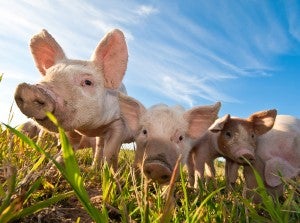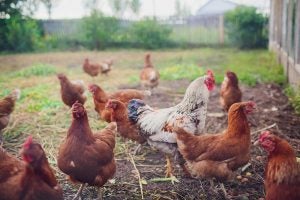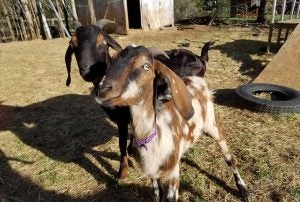There are a lot of exciting upgrades and new technologies in agricultural production. From precision GPS locating tools to robots and drones there is a lot to anticipate in the future of agriculture. But what if you can’t afford all of it just yet? Or perhaps your operation is smaller and larger machinery or modern tech doesn’t appear to have a good ROI for the land that you farm? It’s understandable that you’d want to pass on a machine that costs a quarter of a million dollars or more for just a few acres.
So how can smaller operations diversify their farm to be more efficient? Adding animals is one option — or at least finding new ways to use the ones you may already have. He are some of the ways I strategically use my livestock and poultry to improve my land, control pests, and make the most of my space.

Swine
On my farm I have goats, pigs, chickens, ducks and geese. I also have a market garden and a vineyard.
When I planned out my market garden last fall I had to think about how I was going to prepare the area for laying down irrigation and planting. The land there had laid fallow for a couple years, and the soil was compacted and quite adept at growing weeds. So I pastured my pigs in the area I intended to plant in. Pigs love to get their noses into the dirt — way into the dirt! I leveraged their natural instinct to root around in the soil to my advantage.
When it became time to move them out of the pasture, deeply rooted weeds had been uprooted with their root systems catastrophically disturbed. I don’t have a tiller, so the pigs did a great job for me. And pigs aren’t the only animals that can benefit a growing space.

Poultry/waterfowl
As far as farm animals go, chickens and waterfowl are some of the most versatile. Chickens are great for insect control. They can help keep down tick populations in the summer, they eat slugs, grasshoppers and other pests that can be detrimental to gardens and crops. They scratch at the ground while they look for bugs and plant matter to eat, which has the added benefit of aerating topsoil.
If they are allowed access to compost piles they are effective at getting it turned over. Also, they would be eating weed seeds that could germinate and grow. The waterfowl are good for many of these same reasons, just mind their flat feet. They tend to level any vegetation they get close to.

Sheep and goats
Sheep can be raised for protein or hair, but aside from that they can be used for weed and vegetation control due to their grazing habits. Many vineyards use them for keeping vegetation down and handling vine suckers. They tend to keep their eyes on the ground rather than in the canopy of your growing space or vineyard.
Goats can be used to clear more rugged land (like blackberries or brambles) due to their agility and diverse diet that makes them willing to at least taste nearly anything. They are more effective than sheep at clearing out brush and taller vegetation due to their proclivity for browsing rather grazing. Goats can also be used to pack or pull a cart.
There are a lot of reasons to use animals in smaller acreage operations. Benefits include a more varied diet (this, of course, depends on the variety of your available forage), which leads to an overall healthier animal. By offering forage in pasture, your feed bill will be smaller, which in this economy could be a considerable boon. Aside from feed costs, the availability of manure to be applied either composted or raw can improve the quality of your soil. Soil quality matters whether you are growing vegetables or growing pasture for your livestock.
There are some things to consider when integrating animals into your farm operation. For example, timing is everything. Obviously you don’t want to let chickens into a garden that is in season or you will lose food. You also want to make sure you are using the right animal for your goal. Running a herd of goats through a vineyard will cause more harm than good as they will be more than happy to eat the vine’s canopies, as well as the suckers and the vegetation in the rows.
For the sake of food safety, make sure you know your local and state laws for raw manure application to food growing spaces. No matter your intention, live animals wandering through a growing space are going leave poop behind. It’s your responsibility to know which laws apply. In the same vein, you want to make sure all the animals in the space are healthy. There are many livestock- and poultry-specific diseases that humans cannot contract. But there are many that we can, and it’s your responsibility as the farmer to make sure that as much risk of transmission is mitigated as possible.
This isn’t a method for the faint of heart. Proper management is important, but many, including myself, feel that the positives drastically outweigh any negatives.
Start small, keep it simple and farm on.
Brianna Scott is a veteran farmer who lives in Eastern Washington while earning her Master’s of Science in Agriculture from Washington State University. She is active in the veteran ag community and raises poultry and livestock while growing a large market garden.



